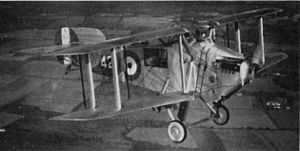Avro Bison Video - Electric RC scale model
|
|
Avro Bison
Bison

Picture - Avro Bison II
Role: Fleet Spotter/Reconnaissance
Manufacturer: Avro
First flight: 1921
Introduced: 1922
Retired: 1929
Status: Retired
Primary users: Fleet Air Arm
Royal Air Force
Number built: 55
The Avro 555 Bison was a British single-engined fleet spotter/reconnaissance aircraft built by Avro.
Development and design
The Bison was designed to meet the British Specification 3/21 for a carrier based fleet spotter and reconnaissance aircraft. An order for three prototypes was placed in October 1921, together with three of the competing design from Blackburn Aircraft, the Blackburn Blackburn. Avro's design, the Type 555 Bison, was a two-bay biplane, powered, like the Blackburn, by a Napier Lion engine. The deep slab-sided fuselage was constructed of steel tube, with the pilot sitting in an open cockpit forward of the wings, and the engine cowling sloping steeply down ahead of the pilot. An enclosed cabin with large rectangular windows on each side housed the navigator and radio operator and all their equipment, with sufficient room room to stand upright, while a cockpit for a gunner armed with a Lewis gun on a Scarff ring was provided in the rear fuselage. The upper wings were mounted directly on the top of the fuselage.
The first prototype flew in 1921, with an order for 12 Bison Is following. The aircraft had handling problems, however, caused by interference of the pilots cockpit with the airflow over the upper wing. This was resolved by revising the wing design of the second prototype, raising the centre section of the upper wing by 2 ft (0.6 m) and removed dihedral from the upper wings, flying in this form in April 1923. Further production orders followed with these modification incorporated as the Bison II, while some Bison Is were modified to a similar standard, sometimes known as the Bison IA. A Bison I was fitted with floats and retractable wheels but tests proved the design was not suitable for seaborne use.
Operational history
Although designed for a naval requirement the first deliveries were to the Royal Air Force in 1922 to replace the Westland Walrus for coastal reconnaissance work with No. 3 Squadron RAF. In April 1923, 3 Squadron was broken up to form a number of Fleet Spotter Flights of the Fleet Air Arm, Naval aircraft served on HMS Argus,HMS Eagle and Furious and on-shore at Gosport, England and Hal Far, Malta. The aircraft were retired in 1929 when they were replaced by the Fairey IIIF.
Operators
United Kingdom
Royal Navy
Royal Air Force
No. 3 Squadron RAF
Specifications (Bison II)
Data from Avro Aircraft since 1908
General characteristics
Crew: 4
Length: 36 ft 0 in (10.98 m)
Wingspan: 46 ft 0 in (14.02 m)
Height: 14 ft 2 in (4.32 m)
Wing area: 630 ft² (58.6 m²)
Empty weight: 4,116 lb (1,871 kg)
Max takeoff weight: 6,132 lb (2,787 kg)
Powerplant: 1x— Napier Lion II, 480 hp (358 kW)
Performance
Maximum speed: 108 mph (94 knots, 174 km/h)
Cruise speed: 90 mph (78 knots, 145 km/h)
Range: 360 mi (313 nmi, 580 km)
Service ceiling: 12,000 ft (3,660 m)
Rate of climb: 450 ft/min (2.3 m/s)
Armament
Guns: 1 x— fixed forward firing .303 in Vickers machine gun and 1 x— .303 in (7.7 mm) Lewis Gun on Scarff ring
Bombs: Provision for underwing bomb racks
Comparable aircraft
Blackburn R.1 Blackburn
Harlin, Eric J. "The Sea-Going Bison". Air Enthusiast (Twenty-two, August-November 1983): pp. 40-51.
Jackson, A.J. (1990). Avro Aircraft since 1908. London: Putnam. ISBN 0-85177-834-8.
Thetford, Owen (1978). British Naval Aircraft since 1912 (Fourth ed.). London: Putnam. ISBN 0 370 30021 1.
The Illustrated Encyclopedia of Aircraft (Part Work 1982-1985). Orbis Publishing.
Avro Bison Pictures and Avro Bison for Sale.
Living Warbirds: The best warbirds DVD series.
Source: WikiPedia